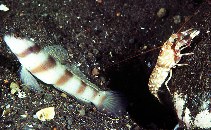| Family: |
Gobiidae (Gobies), subfamily: Gobiinae |
| Max. size: |
13 cm SL (male/unsexed) |
| Environment: |
reef-associated; brackish; marine; depth range 2 - 43 m |
| Distribution: |
Indo-Pacific: Red Sea to Samoa, north to the Amami Islands, Ryukyu Islands. south to the Great Barrier Reef; throughout Micronesia. |
| Diagnosis: |
Dorsal spines (total): 7-7; Dorsal soft rays (total): 12-12; Anal spines: 1-1; Anal soft rays: 12-12. Differs from A. wheeleri by having dull brown bars and more lateral scale rows (Ref. 1602). Characterized by yellow-white body color with five brown bars on head and body; usually with narrow orange bars on lower half of side in between each brown bar; dorsal fins with tiny yellow spots; pelvic fins basally joined by membranes; head and midline of nape without scales; longitudinal scale series 72-78; greatest depth of body 4.3-5.5 in SL; rounded caudal fin, slightly longer than head (Ref. 90102). |
| Biology: |
Inhabits sandy areas of outer lagoon and seaward reefs, with a pale brown or marbled brown and white alpheid shrimp (Ref. 1602). Also found in estuaries and usually at moderate depth of about 20 meters on deeper slopes (Ref. 48637). |
| IUCN Red List Status: |
Least Concern (LC); Date assessed: 25 June 2018 Ref. (130435)
|
| Threat to humans: |
harmless |
Source and more info: www.fishbase.org. For personal, classroom, and other internal use only. Not for publication.
